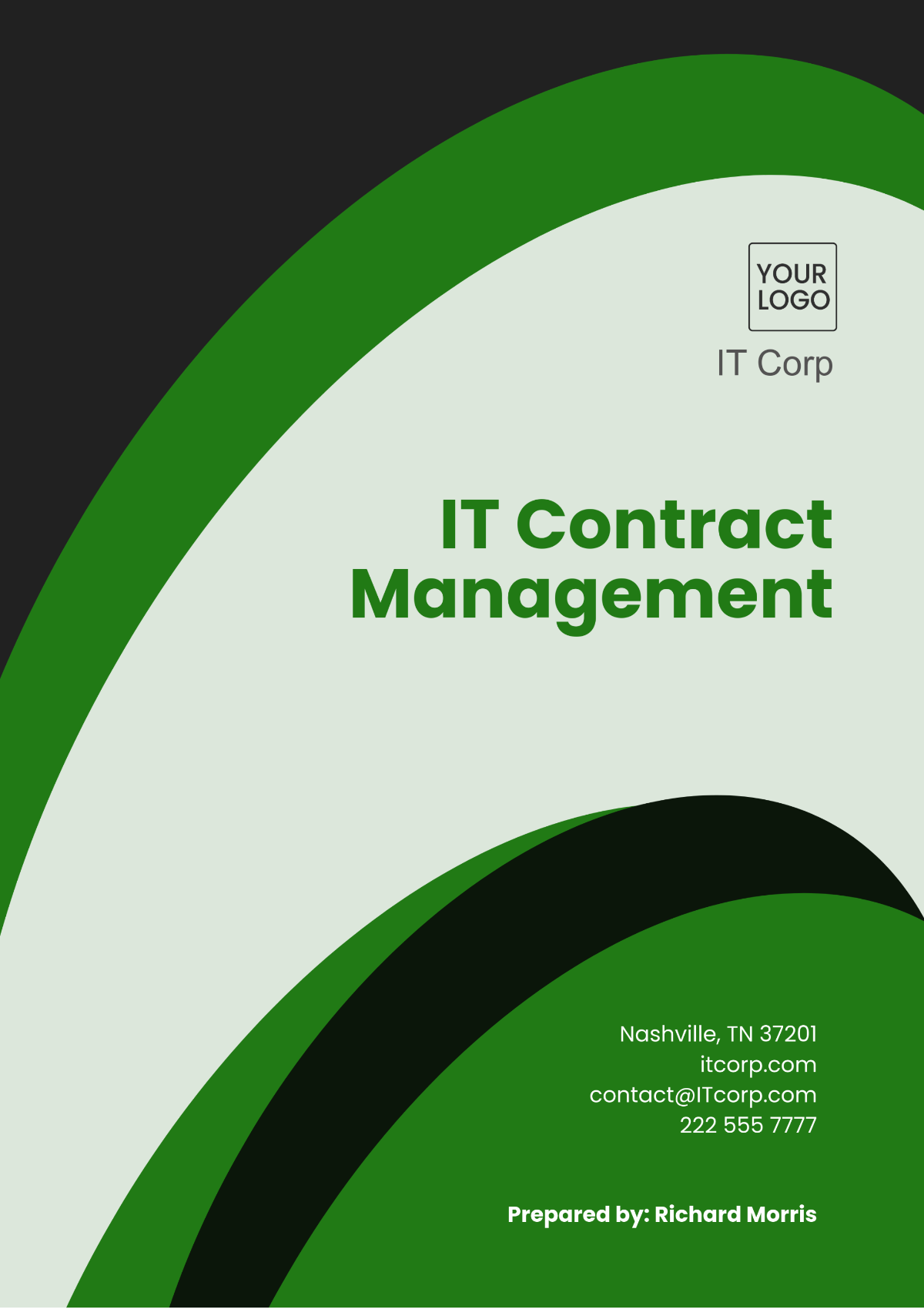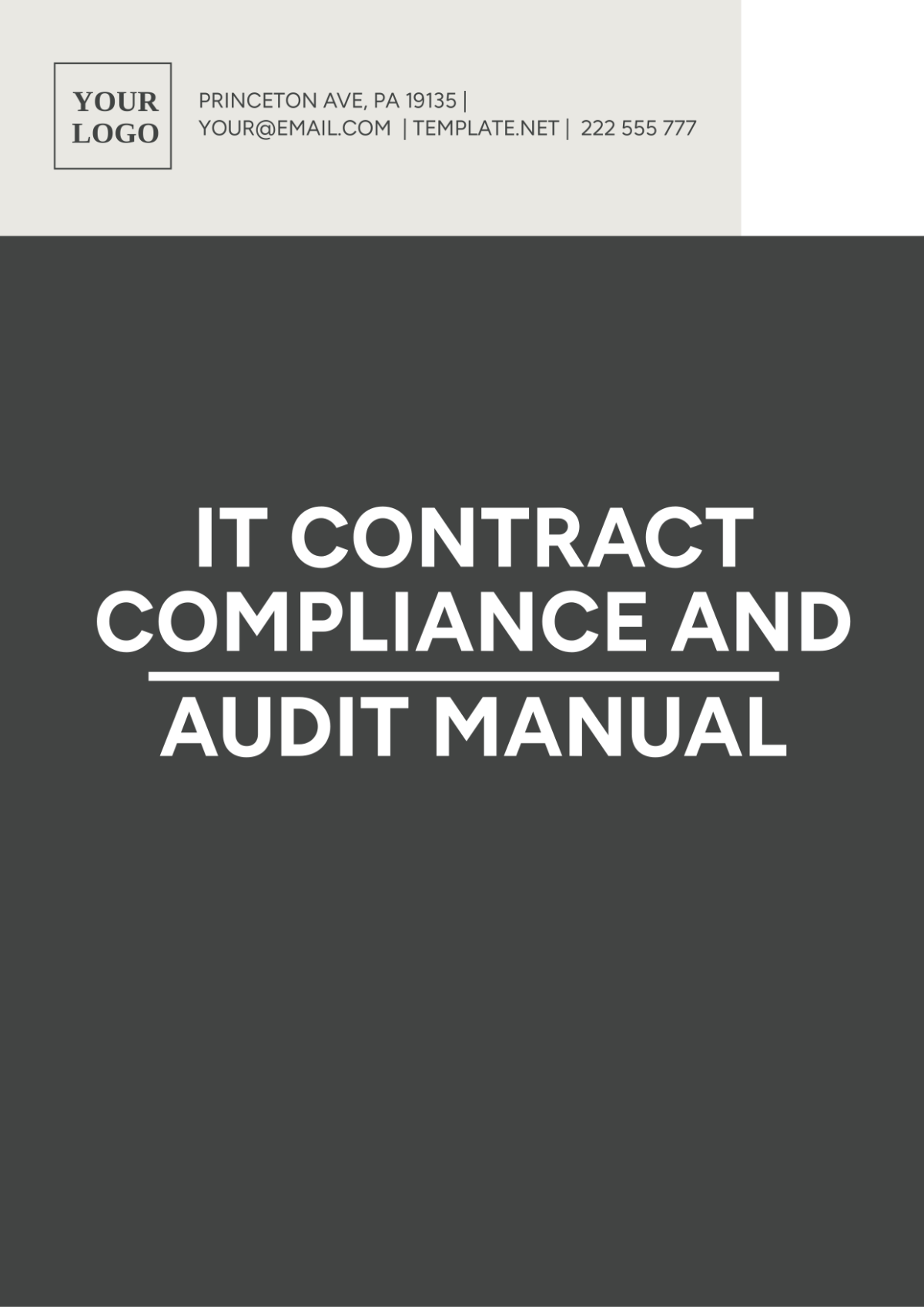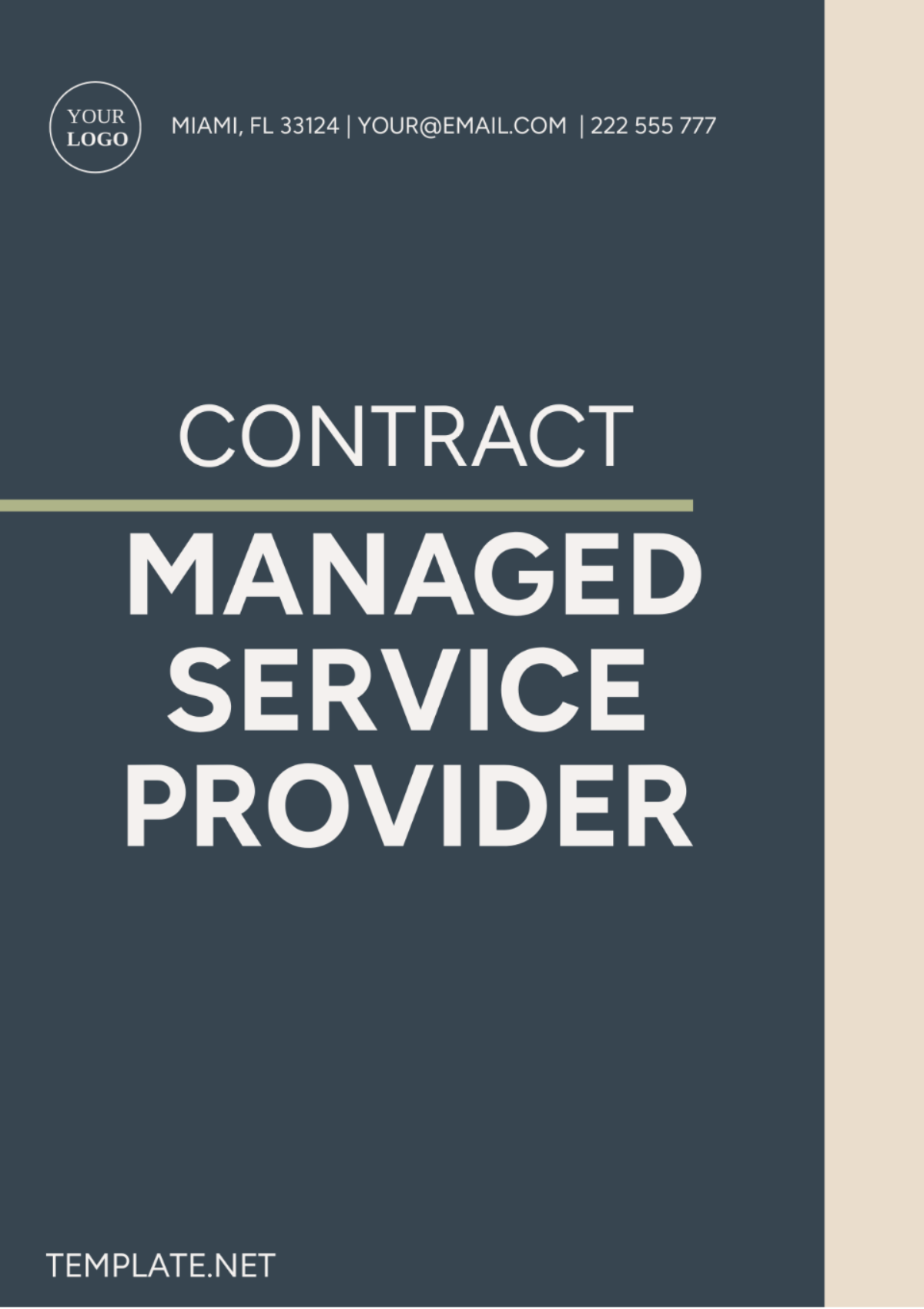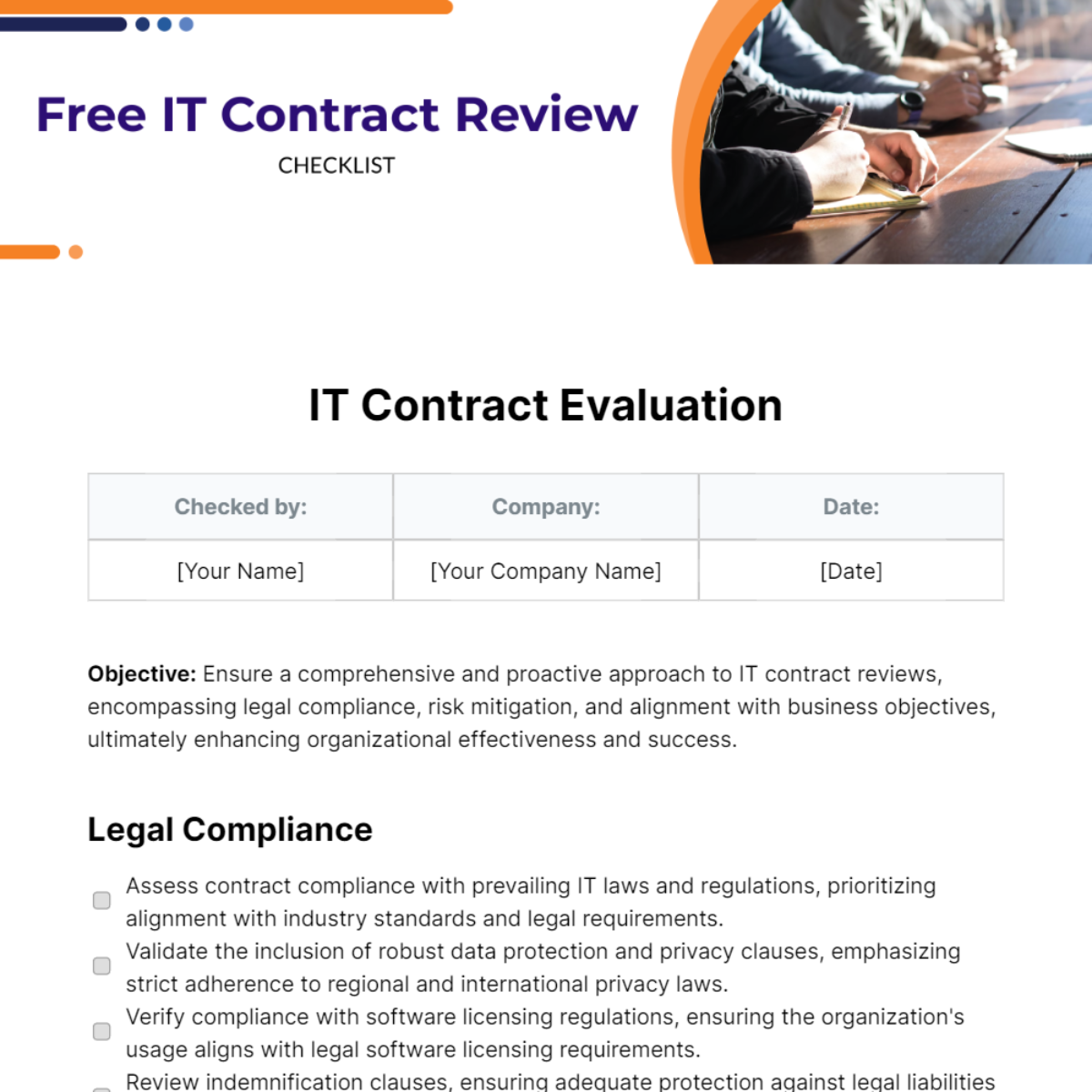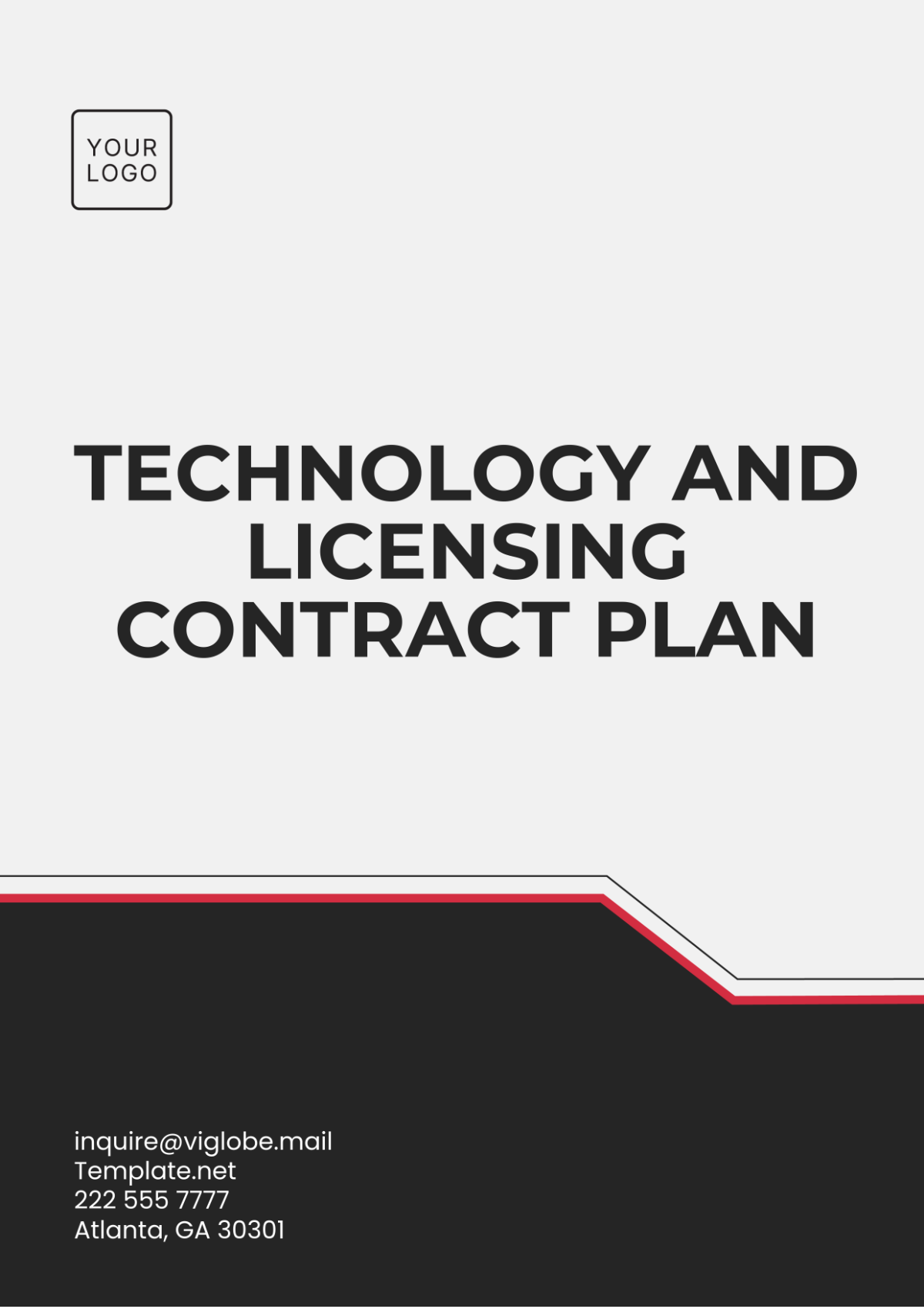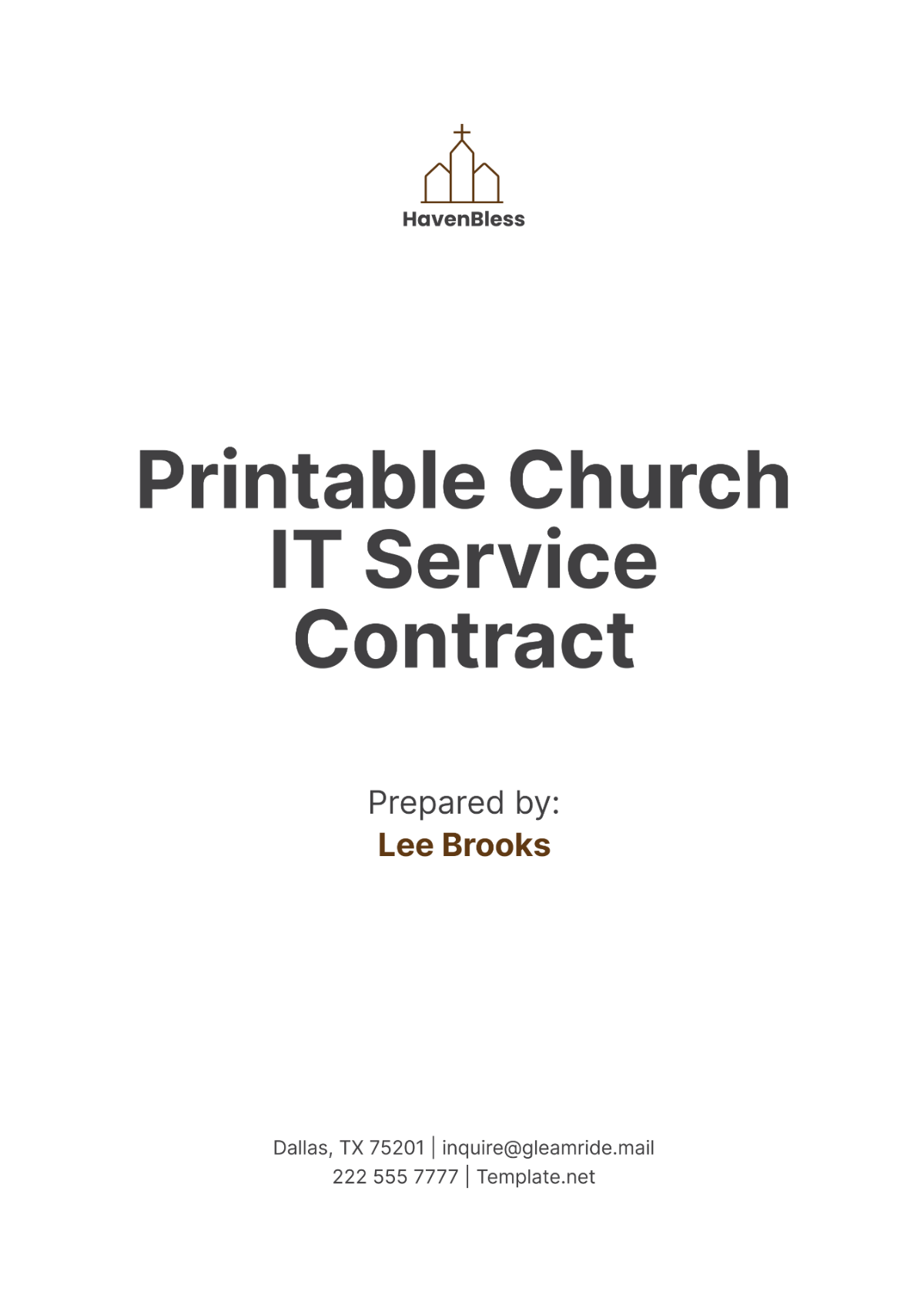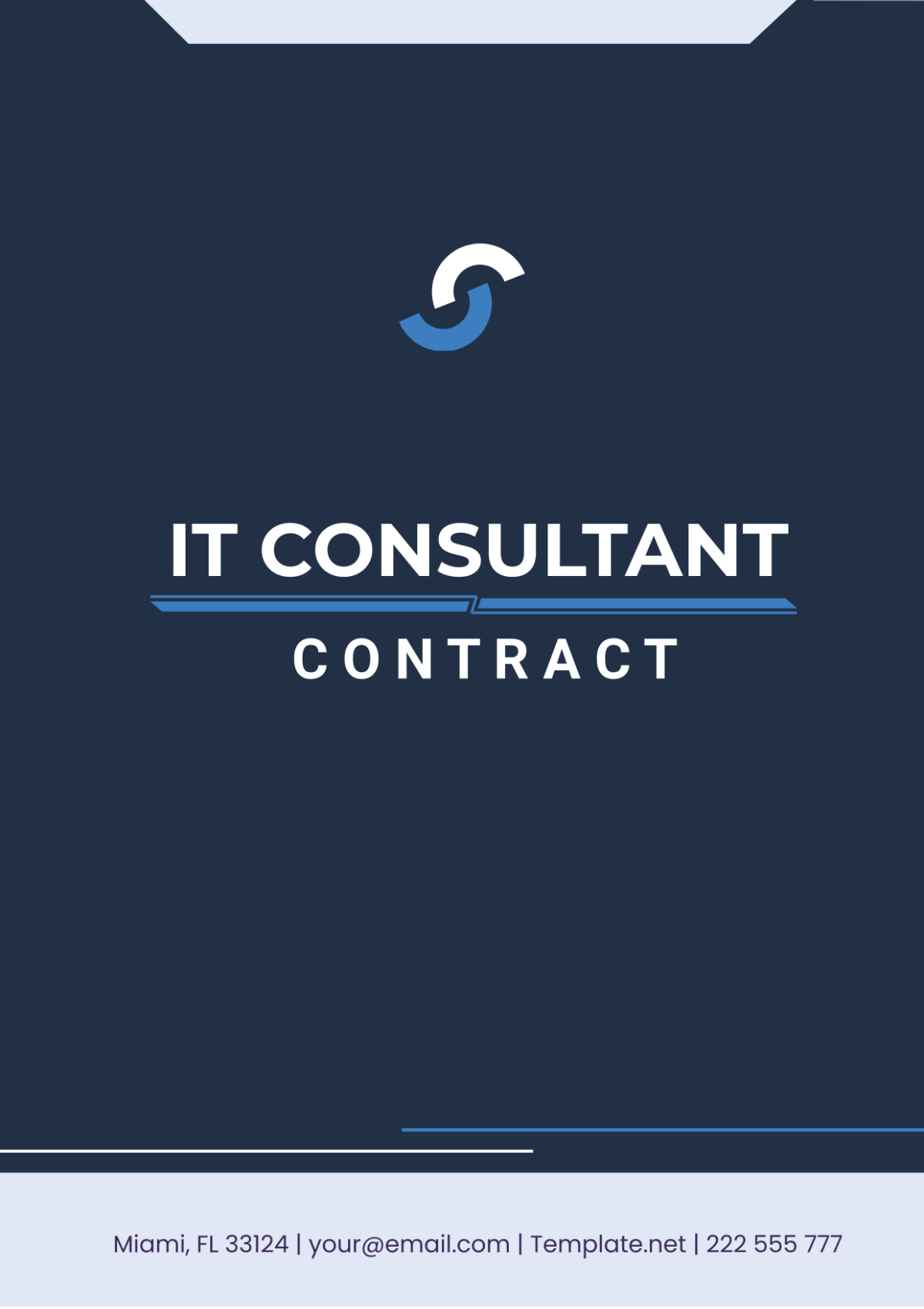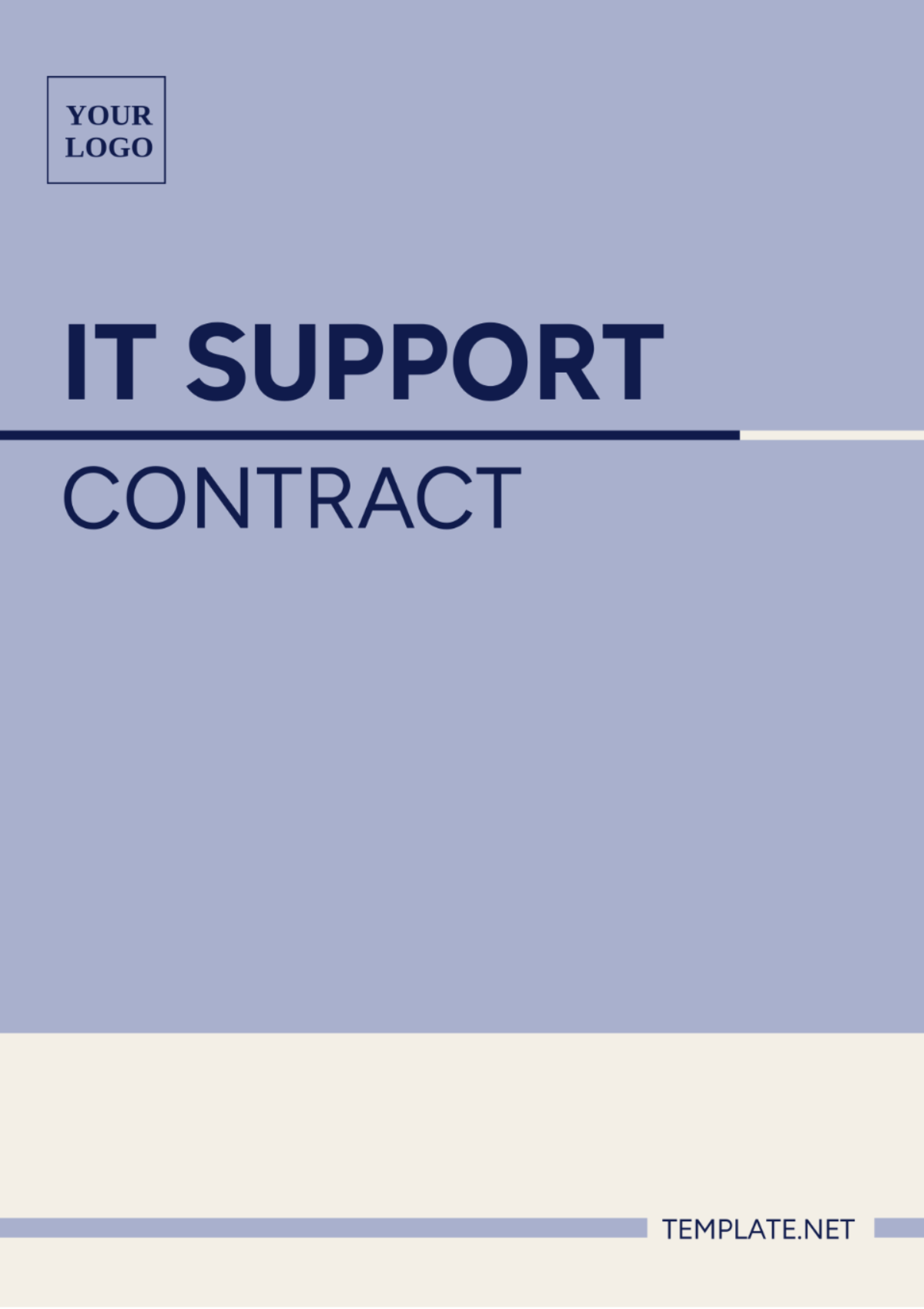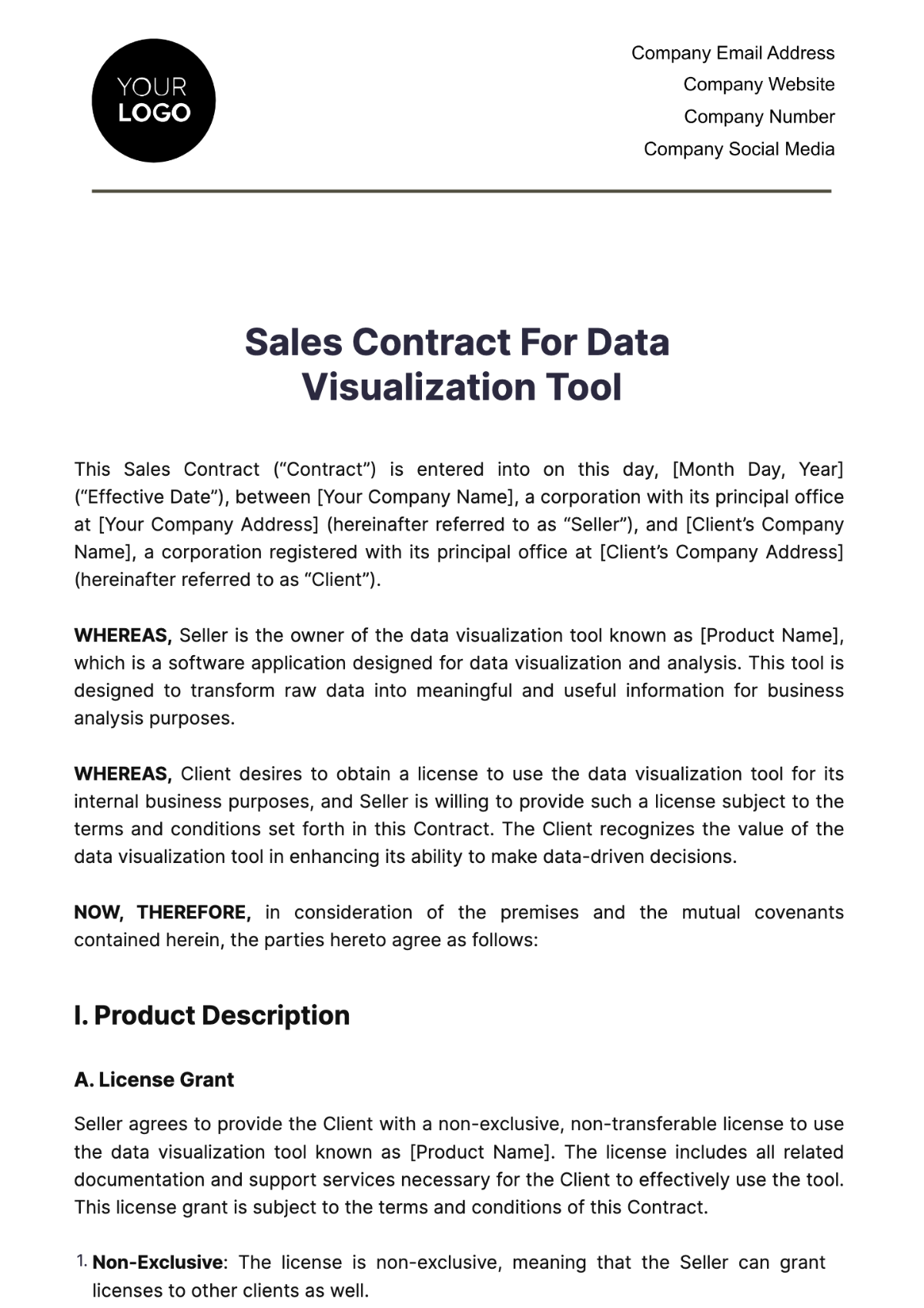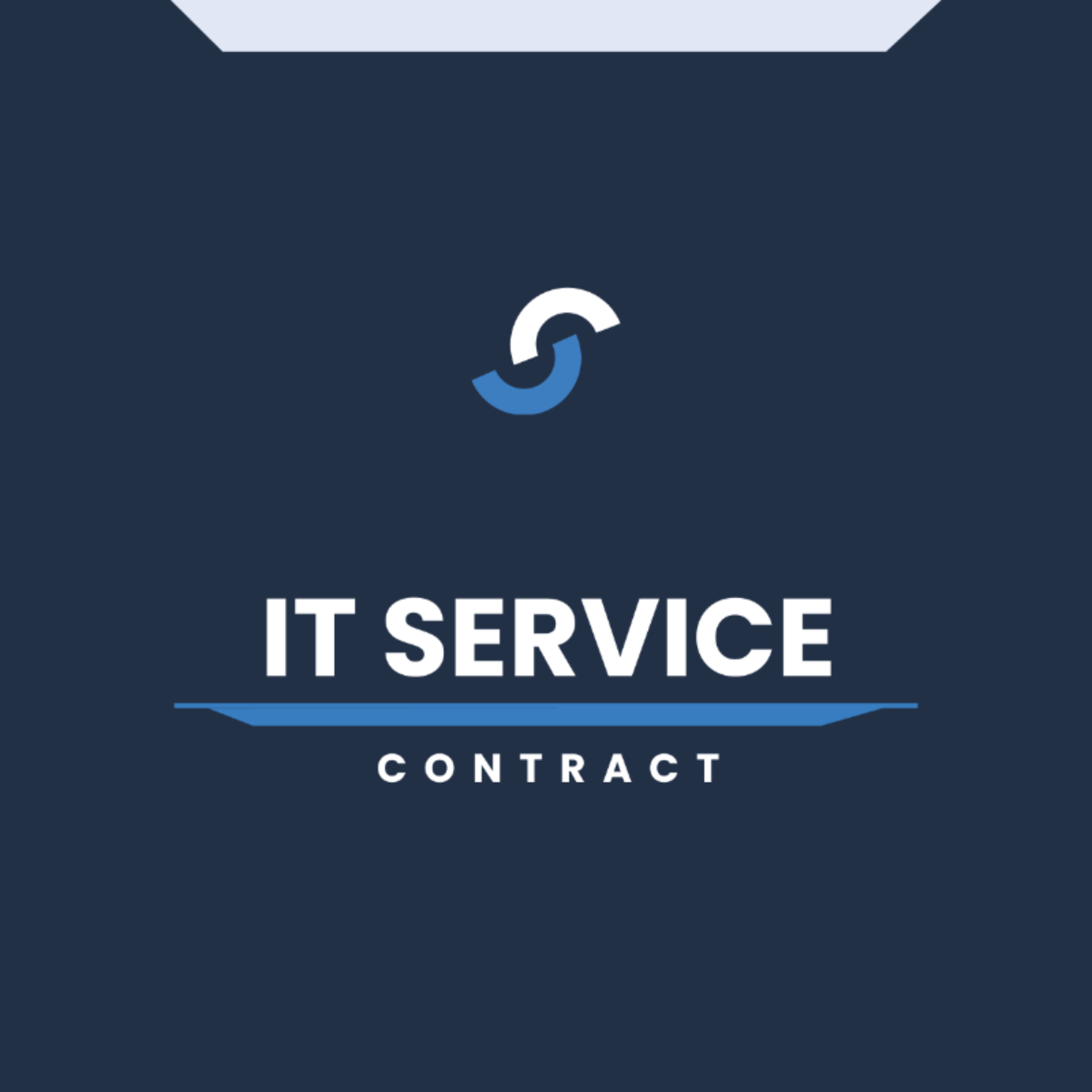IT Contract Management
[Your Company Name]
Effective Date: [Date]
Contract Number: [Your Company Number]
Parties Involved: [Your Company Name] and [Client Name]
Term: [2050–2055]
I. Introduction
A. Purpose of the IT Contract Management
IT Contract Management is a strategic function that encompasses the creation, execution, and oversight of IT-related contracts. Its primary goal is to ensure that all contractual obligations are met, which in turn supports the broader objectives of the organization. Effective IT Contract Management not only helps in mitigating risks and ensuring compliance but also plays a crucial role in enhancing the operational efficiency of IT services.
[Your Company Name] is committed to delivering exceptional contract management services by adhering to best practices, leveraging advanced technologies, and maintaining strong communication channels with clients. The purpose of this agreement is to define the framework within which IT contracts will be managed, ensuring that all parties have a clear understanding of their responsibilities and expectations.
By managing contracts effectively, [Your Company Name] aims to achieve the following objectives:
Ensure Compliance: Guarantee that all contractual obligations are met in accordance with relevant laws, regulations, and internal policies.
Enhance Performance: Monitor and evaluate contract performance to ensure that all parties fulfill their commitments and deliverables.
Mitigate Risks: Identify potential risks associated with IT contracts and implement strategies to mitigate these risks.
Optimize Value: Maximize the value derived from IT contracts through effective negotiation, management, and performance evaluation.
Streamline Processes: Implement efficient processes for contract creation, execution, monitoring, and renewal.
B. Objectives
The key objectives of IT Contract Management under this agreement are as follows:
Establish Clear Expectations: Define and document the roles, responsibilities, and expectations for both [Your Company Name] and [Client Name] to ensure clarity and avoid misunderstandings.
Facilitate Effective Communication: Develop mechanisms for regular communication between the parties to address any issues or concerns promptly.
Promote Accountability: Hold all parties accountable for their obligations under the contract, ensuring that performance standards are met and any deviations are addressed.
Enhance Contract Visibility: Provide transparency into the status and performance of contracts through regular reporting and monitoring.
Support Continuous Improvement: Continuously review and improve contract management practices to adapt to changes in the IT landscape and business needs.
II. Contract Overview
A. Contract Types
This section outlines the various types of contracts that [Your Company Name] will manage. Each contract type has specific characteristics and requirements that must be addressed to ensure effective management.
Service Level Agreements (SLAs): SLAs are formal agreements that specify the level of service expected from a vendor. They include metrics for performance measurement, such as response times, uptime guarantees, and issue resolution times. SLAs are critical for ensuring that IT services meet agreed-upon standards and provide a basis for performance evaluations.
Software License Agreements: These agreements govern the terms under which software is used. They outline licensing rights, restrictions on use, and responsibilities related to software maintenance and support. Software License Agreements are essential for managing software assets and ensuring compliance with licensing terms.
Hardware Procurement Contracts: These contracts cover the acquisition, installation, and maintenance of hardware equipment. They specify the terms of purchase, delivery schedules, warranty provisions, and support services. Hardware Procurement Contracts are crucial for ensuring that IT infrastructure is acquired and maintained effectively.
Cloud Services Agreements: Cloud Services Agreements define the terms of cloud-based services, including data storage, processing, and access. They address issues such as data security, service availability, and performance. Cloud Services Agreements are important for managing relationships with cloud service providers and ensuring that cloud services meet organizational needs.
IT Outsourcing Agreements: These agreements outline the terms under which IT functions are outsourced to third-party providers. They include provisions for service delivery, performance standards, and governance. IT Outsourcing Agreements are essential for managing outsourced IT services and ensuring that they align with business objectives.
B. Contract Lifecycle
The contract lifecycle encompasses all phases from initial conception through to completion and/or renewal. Each stage is integral to the success of IT Contract Management and involves several key activities:
Initiation
Identification of Need: Determine the necessity for a new contract based on business requirements, project needs, or operational changes. This involves assessing current contracts and identifying gaps or opportunities for new agreements.
Scope Definition: Clearly define the scope of the contract, including objectives, deliverables, timelines, and responsibilities. This step ensures that both parties have a shared understanding of what the contract will cover.
Stakeholder Engagement: Involve relevant stakeholders in the planning phase to ensure that all perspectives and requirements are considered.
Drafting and Negotiation
Contract Drafting: Develop a draft contract that includes all necessary terms and conditions, reflecting the agreed-upon scope and requirements. This draft serves as the basis for further discussions and modifications.
Negotiation: Engage in negotiations with the other party to finalize the contract terms. This may involve multiple rounds of discussions to address concerns, refine terms, and reach a mutual agreement.
Legal Review: Ensure that the draft contract is reviewed by legal experts to confirm that it complies with applicable laws and regulations and protects the interests of both parties.
Approval and Execution
Internal Approval: Obtain necessary internal approvals from key decision-makers within [Your Company Name] before finalizing the contract. This may involve reviews by finance, legal, and procurement departments.
Finalization: Once the contract terms are agreed upon, both parties sign the contract. Ensure that all signatures and formalities are completed, and that the final version is distributed to relevant stakeholders.
Documentation: Store the executed contract in a secure repository and update records to reflect the new agreement.
Performance and Monitoring
Ongoing Management: Monitor the performance of the contract to ensure that all parties are meeting their obligations. This involves regular reviews, performance assessments, and addressing any issues that arise.
Performance Reporting: Prepare and share performance reports with stakeholders, highlighting key metrics, compliance with SLAs, and any deviations from the agreed terms.
Issue Resolution: Address and resolve any issues or disputes that arise during the contract's term, using established processes for escalation and resolution.
Renewal or Termination
Renewal Evaluation: Conduct a thorough review of the contract's performance and relevance before the renewal date. Assess whether the contract should be renewed, renegotiated, or allowed to expire.
Amendments: If renewing, make any necessary amendments to the contract to reflect changes in terms, scope, or conditions. Document these amendments and ensure they are agreed upon by both parties.
Termination: If terminating, follow the procedures outlined in the contract for formal termination. This may involve providing notice, settling outstanding obligations, and ensuring a smooth transition.
III. Roles and Responsibilities
A. Responsibilities of [Your Company Name]
Contract Creation
Drafting: Develop comprehensive contract documents that clearly outline the terms, conditions, and expectations for both parties. Ensure that contracts are tailored to specific needs and compliant with legal and regulatory requirements.
Review: Regularly review and update contract templates to reflect changes in laws, regulations, and industry best practices.
Negotiation Support
Facilitation: Assist in negotiations by providing expertise and guidance on contract terms, pricing, and performance metrics. Ensure that negotiations are conducted in a manner that aligns with organizational goals and client expectations.
Documentation: Maintain accurate records of negotiation discussions and agreements to ensure transparency and accountability.
Monitoring Compliance
Tracking: Implement systems for tracking compliance with contract terms, including performance metrics, deliverables, and payment schedules. Regularly review contract performance to ensure adherence.
Audits: Conduct periodic audits to verify compliance and address any discrepancies or issues.
Risk Management
Assessment: Identify and assess potential risks associated with each contract, including financial, operational, and legal risks. Develop risk mitigation strategies to address these risks proactively.
Mitigation: Implement measures to minimize the impact of identified risks, such as contingency plans, insurance, and performance bonds.
Record Keeping
Storage: Maintain a secure and organized repository for all contract documents, including original agreements, amendments, and related correspondence. Ensure that records are easily accessible to authorized personnel.
Retention: Adhere to document retention policies and legal requirements for record keeping. Ensure that records are retained for the required duration and securely disposed of when no longer needed.
Performance Evaluation
KPIs: Monitor contract performance using key performance indicators (KPIs) to assess whether the vendor is meeting agreed-upon standards. Evaluate performance regularly and provide feedback to both internal and external stakeholders.
Reviews: Conduct performance reviews with vendors and clients to discuss achievements, address issues, and identify opportunities for improvement.
B. Responsibilities of the Client ([Client Name])
Timely Communication
Responsiveness: Respond promptly to communications from [Your Company Name] regarding contract updates, performance issues, and other relevant matters. Ensure that communication is clear and effective.
Feedback: Provide timely feedback on contract performance, service delivery, and any concerns or issues that arise.
Financial Responsibilities
Payments: Ensure that payments are made according to the terms outlined in the contract. This includes adhering to payment schedules and resolving any billing issues promptly.
Budgeting: Work with [Your Company Name] to manage the budget and address any financial adjustments or changes that may impact the contract.
Service Reviews
Participation: Actively participate in regular performance reviews and contract evaluations. Provide input on service quality, delivery, and areas for improvement.
Action Plans: Collaborate with [Your Company Name] to develop and implement action plans for addressing performance issues and enhancing service delivery.
Providing Access
Systems Access: Grant [Your Company Name] access to necessary systems, documents, and personnel required for contract management and performance monitoring.
Collaboration: Collaborate with [Your Company Name] to facilitate smooth operations and ensure that all parties have the resources and information needed to fulfill their obligations.
IV. Contract Performance Monitoring
A. Key Performance Indicators (KPIs)
KPIs are critical for measuring the effectiveness of contracts and ensuring that services are delivered according to agreed-upon standards. The following table outlines typical KPIs used in IT Contract Management:
KPI Name | Description | Target (2050–2055) |
|---|---|---|
Uptime Percentage | Measures the percentage of time that services are operational and available. This metric is crucial for ensuring service reliability and minimizing downtime. | [99.9%] |
Issue Resolution Time | Tracks the average time taken to resolve IT issues from the moment they are reported. A shorter resolution time indicates efficient issue management and support. | Less than [24] hours |
Vendor Response Time | Measures the time taken for vendors to respond to support requests or issues. Timely responses are essential for maintaining service quality and addressing concerns promptly. | Within [2] hours |
Budget Adherence | Monitors whether the contract stays within the agreed financial limits. Effective budget management ensures cost control and prevents overspending. | [±5%] variance allowed |
Security Incident Rate | Tracks the number of security incidents reported. A lower incident rate indicates robust security measures and effective risk management. | Zero incidents per quarter |
B. Service-Level Agreements (SLAs)
SLAs define the expected level of service and establish metrics for performance evaluation. [Your Company Name] will monitor compliance with SLAs to ensure that services meet agreed-upon standards and deliver value to clients.
Response Times
Critical Incidents: The vendor must respond to critical incidents within a specified timeframe, such as [2] hours, to ensure rapid resolution of high-impact issues.
Non-Critical Incidents: Response times for non-critical incidents may be longer but should still meet agreed-upon standards to ensure timely support.
Downtime Allowance
Monthly Downtime: The contract will specify the allowable downtime per month, such as [0.1%] of total operational time. This metric ensures that services are consistently available and reliable.
Reporting: Downtime incidents must be reported and documented to track performance and address any recurring issues.
Data Security
Compliance: Vendors are required to adhere to data protection laws and regulations to ensure that all sensitive data remains secure. This includes implementing appropriate security measures and protocols.
Audits: Regular security audits and assessments will be conducted to verify compliance and address any potential vulnerabilities.
V. Risk Management
A. Identifying Risks
Effective risk management involves identifying potential risks early in the contract lifecycle and developing strategies to mitigate them. The following types of risks are commonly associated with IT contracts:
Compliance Risk
Regulatory Changes: Changes in laws or regulations may impact contract terms or require updates to compliance practices.
Legal Obligations: Failure to meet legal obligations related to data protection, intellectual property, or other areas can result in legal consequences and financial penalties.
Performance Risk
Service Quality: Vendors may fail to meet performance standards, leading to disruptions in service delivery and unsatisfactory outcomes.
Delivery Delays: Vendors may not meet agreed-upon deadlines for deliverables, causing project delays or operational inefficiencies.
Financial Risk
Cost Overruns: Unexpected costs, such as changes in scope or increased vendor fees, may lead to exceeding the budget.
Vendor Insolvency: The risk of a vendor going out of business or facing financial difficulties could impact contract fulfillment.
Data Security Risk
Data Breaches: Unauthorized access to sensitive data may result in data breaches, causing reputational and financial damage.
Compliance with Security Standards: Vendors may fail to implement adequate security measures, increasing the risk of cyberattacks or data loss.
B. Risk Mitigation Strategies
[Your Company Name] will implement the following strategies to mitigate risks and ensure effective contract management:
Contractual Protections
Penalties for Non-Compliance: Include clauses that impose financial penalties or termination rights in case of non-compliance with performance standards or legal obligations.
Insurance Requirements: Require vendors to maintain adequate insurance coverage, such as liability insurance or cyber insurance, to protect against potential financial losses.
Regular Audits and Assessments
Compliance Audits: Conduct regular audits to ensure vendors adhere to contractual obligations and legal requirements, especially regarding data protection and security.
Performance Audits: Evaluate vendor performance periodically to identify any deviations from agreed-upon standards and take corrective actions.
Vendor Management
Contingency Plans: Develop contingency plans in case a vendor is unable to meet its obligations, including alternative vendors or in-house solutions.
Financial Monitoring: Regularly monitor the financial health of vendors to identify potential insolvency risks early.
Data Security Measures
Encryption and Access Control: Ensure that all data shared with vendors is encrypted and access controls are in place to prevent unauthorized access.
Security Audits: Perform regular security audits of vendors to verify that they adhere to security best practices and standards, such as ISO 27001 or SOC 2.
VI. Contract Management Technologies
A. Contract Management Systems (CMS)
Using advanced technology is critical for efficiently managing IT contracts. [Your Company Name] utilizes a robust Contract Management System (CMS) to support the entire contract lifecycle. This system automates many of the manual tasks involved in contract management, including drafting, negotiation, execution, and monitoring.
Contract Repository
Centralized Storage: The CMS provides a centralized, secure repository for storing all contracts and related documents. This ensures that contract information is easily accessible to authorized personnel.
Version Control: The system tracks all versions of a contract, ensuring that changes and updates are accurately recorded and approved.
Automated Alerts and Notifications
Expiration and Renewal Alerts: The CMS automatically generates alerts for upcoming contract expirations, allowing [Your Company Name] and clients to take proactive steps for renewal or termination.
Compliance Notifications: Notifications can be set up to alert stakeholders when performance metrics fall below agreed-upon standards, enabling timely corrective actions.
E-Signature Integration
Streamlined Approvals: The CMS integrates with e-signature solutions to facilitate the quick and secure execution of contracts. This reduces the time required for the approval process and ensures that contracts are executed promptly.
Audit Trail: E-signature integration also provides a detailed audit trail, ensuring that all signatures are traceable and legally binding.
Data Analytics and Reporting
Performance Metrics: The CMS provides real-time analytics and reports on contract performance, helping stakeholders monitor compliance with SLAs and KPIs.
Risk Analysis: The system identifies potential risks, such as vendor performance issues or cost overruns, through data-driven insights.
B. Artificial Intelligence and Machine Learning
The use of Artificial Intelligence (AI) and Machine Learning (ML) technologies is transforming the way contracts are managed. [Your Company Name] employs AI/ML tools to enhance contract management processes by automating complex tasks and improving decision-making.
Contract Review and Analysis
AI-Powered Review: AI can rapidly analyze contracts to identify key terms, conditions, and risks. This speeds up the review process and ensures that all critical elements are identified and addressed.
Risk Identification: AI algorithms can flag potential risks in contracts, such as ambiguous terms or clauses that may expose [Your Company Name] to legal liabilities.
Predictive Analytics
Performance Predictions: Machine learning models can predict future performance issues based on historical data, allowing [Your Company Name] to take preventive measures.
Financial Forecasting: Predictive analytics can be used to forecast financial outcomes, helping stakeholders manage budgets more effectively.
VII. Compliance and Legal Considerations
A. Regulatory Compliance
Adherence to relevant laws and regulations is a critical aspect of IT Contract Management. [Your Company Name] ensures that all contracts comply with the legal frameworks applicable to the industry and geographical location.
Data Protection Regulations
General Data Protection Regulation (GDPR): Ensure that contracts involving data processing comply with GDPR requirements, including data subject rights and cross-border data transfer restrictions.
California Consumer Privacy Act (CCPA): For contracts involving U.S. residents, ensure compliance with CCPA requirements related to data privacy and consumer rights.
Intellectual Property (IP) Rights
IP Ownership: Clearly define IP ownership in contracts, particularly in software development and IT service agreements. Specify who retains ownership of developed software, systems, or data.
Licensing: Ensure that all software and hardware licensing terms comply with applicable laws and are clearly stated in contracts to avoid disputes.
Industry-Specific Regulations
Health Information: For contracts involving healthcare IT, ensure compliance with regulations like the Health Insurance Portability and Accountability Act (HIPAA) to protect sensitive health information.
Financial Services: Contracts related to financial IT services must comply with regulations like the Payment Card Industry Data Security Standard (PCI DSS) to ensure secure payment processing.
B. Legal Dispute Resolution
In the event of a legal dispute, it is essential to have clear mechanisms in place for resolution. [Your Company Name] incorporates the following dispute resolution provisions in its contracts:
Mediation and Arbitration
Mediation: Contracts may include clauses requiring mediation before resorting to litigation. This allows parties to resolve disputes amicably with the help of a neutral third party.
Arbitration: If mediation fails, arbitration may be used as an alternative to litigation. Arbitration is generally faster and less expensive than court proceedings.
Governing Law
Jurisdiction: Specify the governing law and jurisdiction for contract disputes. This ensures that any legal issues are resolved under the laws of a specific country or state.
Termination Clauses
Breach of Contract: Clearly outline the conditions under which the contract can be terminated due to breach of contract, including failure to meet performance standards, non-compliance with legal requirements, or financial insolvency.

